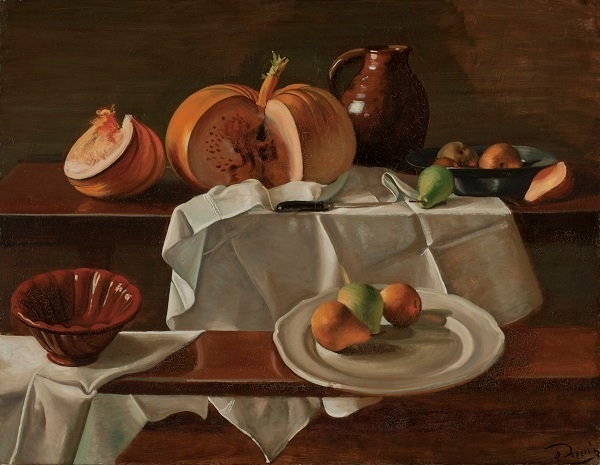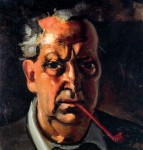
André Derain
French, 1880-1954
Still Life with Pumpkin (La Citrouille), 1939
oil on canvas
40 x 52 in.
SBMA, Bequest of Wright S. Ludington
1993.1.4

Derain self-portrait from 1953, a year before his death, painted in the subdued color palette that he preferred in his later years.
“Such doctrines have above all taught us to belong to our own period. However, seized by doubts as I am, I propose to attempt something most difficult; to belong to all time. By doing so, it will lead us towards truth and simplicity and that, if one wishes to adhere to one’s own era, is still more complicated.” – André Derain
RESEARCH PAPER
High up on the wall, hung Salon Style, is an easily missed “Still Life with Pumpkin” in Ludington Court. The canvas has a dark background with earth-toned objects emerging on a table and bench. It is slightly tilted toward the viewer. Keeping company with a Roman copy of Hermes in marble, a gilt surrounded St Ursula, and a 17th-century still life, one could mistake this for a Caravaggio-era work. How surprising to learn that it dates from 1939 by the French artist André Derain. Derain is known for his brightly colored fauvist and cubist works from earlier in the 20th century. How and why did he transition to this neoclassical style?
Derain painted steadily from the early 1900s until he died in 1954. His still life paintings give an overview of his many stylistic and symbolistic attempts in his quest for a true and universal art style. “Still Life with Pumpkin” is perhaps his “grand master” accomplishment, even though it may not be what we today might consider his most innovative work. The painting is richly hued and skillful. His choice of elements is timeless. It is a frontal presentation on two levels with a balance of light and shade. Rich golden and red-brown forms sit on a light cloth against a dark background reminiscent of earlier Spanish or Italian painters. Each object is perfectly rendered down to the seeds and fibers of the pumpkin. It is a culmination of the traditional work he began in the 1920s.
Derain was born in Chatou, a suburb of Paris, in 1880. By the age of 15, he had won a science prize and exhibited much skill in art. He began Engineering School, but after one year he left and in 1898 he entered a Parisian art studio where he met Matisse and Vlaminck. Matisse was 11 years older, but was immediately taken with Derain for both his intellect, and his ability to converse on almost any topic. It was Matisse who convinced Derain’s parents to let him pursue his art full-time. They had the means to help him get started.
Matisse and Derain traveled and painted together in what would be called the “fauvist style.” These early works are brightly colored, exuberant compositions with much movement. Derain admired Matisse’s love of life.
In 1905 Matisse convinced Derain and Vlaminck to show their work in the Salon des Indépendants. While Matisse’s two paintings were derided, Derain sold four of the eight works he exhibited. Ambroise Vollard, art dealer “extraordinaire,” then bought all the work Derain had in his studio. Derain gave credit to Matisse even though Matisse downplayed Derain’s importance in this phase of his career.
About 1908, Derain destroyed all the unfinished work in his studio, decried modern art, and set about to find his universal art form. He was one of the first to be drawn to primitive masks. In 1910 he painted with Picasso in Spain. His paintings of 1912-1914 had quieter colors, his compositions simpler, his brushstrokes beautiful. He then painted elongated, dour figures with black eyes. He shunned other artists and felt isolated.
Derain served in the military through the first world war. In 1919 he started to do theatrical and book design. He designed sets and costumes for many ballets. He made illustrations and woodcuts for books. These formats were traditional and fostered his interest in classical myths, stories, and legends. Through ballets and his classical works, Derain kept aristocratic company with more conservative tastes. He achieved much financial success.
Many young artists followed the imposing Derain for his skill and knowledge of philosophy. In the 1920s Matisse asked Derain to guide his son Pierre’s art studies. Later Pierre became a dealer for Derain’s work. In 1940 Pierre exhibited 12 of Derain’s works. His four large still-life paintings drew the most critical acclaim. “Still Life with Pumpkin” was the most ambitious.
Unlike Matisse’s lifetime explorations of color and composition, Derain’s art explores intellectual ideas. Metaphysical statements of light and dark are evident in his almost black and white “Still Life with Fruit,” 1938. Spiritual ideas in theme and symbolism appear in dead fish and game used as subjects in his still life work. Many of his works show a fascination with classical studies.
“I never lost touch with the Old Masters, and by the age of eighteen, I was already familiar with all existing reproductions of their Masterpieces…for what benefit comes from lack of culture?” (André Derain, the Art Story)
The Nazi regime was taken with Derain’s classical work and tried to encourage him to work on their behalf. He always felt art should be separate from politics. He even refused a commission to paint one of Hitler’s ministers and his family in an effort to separate himself from the political sphere; however, in 1941 he accepted an invitation to an art opening in Germany which the Nazis used as propaganda. This sullied Derain’s reputation at home.
It was not the unsettled climate of the 1930s and the Nazi decree against modern art, but, rather, it seems that Derain’s intellectualism and constant questioning spurred his artistic quests and his everchanging stylist approach. It is hard to recognize him as an artistic constant in many of his works.
In the end, Derain enjoyed success in his lifetime as a gifted artist. Sadly, his legacy was diminished not for lack of skill but perhaps by the lack of innovation in later works that his early works exhibited. Innovation by many artists of his time showed ambitious formal explorations and led the way to abstract and conceptual art later in the twentieth century. Furthermore, his hand is not always recognizable within all the varied works he created. His early works were colorful and abstract. His later works looked backward in subject matter and style. His later works used everything from romantic soft brushwork in golden hues to almost black and white.
While we may not at first recognize its artist, “Still Life with Pumpkin,” with its Old Master aura, and timeless appearance is perhaps, in theory, the timeless accomplishment Derain sought.
Prepared for the Santa Barbara Museum of Art Docent Council by Bobbi Corbin, 2024
BIBLIOGRAPHY
Artnet
https://www.artnet.com/artists/andré-derain
The Art Story
https://www.theartstory.org/artist/derain-andré
Kalitina, N., André Derain, A painter Through the Ordeal by Fire,
Parkstone/Aurora Editions, Bournemouth, England, 1995
Lee, Jane, Derain, Phaidon Press Limited, 1990
Russell, John, Matisse Father and Son, Harry N. Abrams, Inc.
COMMENTS
It is within the genre of still life that Derain most consistently drew on all the layers of his long memory. In the latter part of his oeuvre, from the mid twenties to the forties, his series of still lifes exactly reflect the successive strata of his remembered experience. Unchangeable in essence, beyond fashion and beyond epoch, the objects he assembled offer no point of purchase to contemporary attitudes; they give no place to the ephemera, no room to the mundane or the traces of daily life. One finds there no umbrella, still less a sewing machine or ball-bearings. Derain left all these industrial knick-knacks and machinery to Léger, just as he had left the dazzling bouquets of anemones and green plants to Matisse. He was in fact much more in tune with his faithful friend Georges Braque, especially when the latter restrained his palette and motifs in the early forties, painting the meagre sustenance of a time of famine (black fish or bread). ...
This canvas is the most ambitious and the most fully achieved of the group presented by Pierre Matisse in his New York gallery from mid-April to mid-May, 1940. Like "The Three Baskets", it represents a tour de force, a masterpiece of syncretic interpretation of the old masters that aroused the interest of American critics sensitive to the major quality of these majestic works.
Pierre Matisse spared no efforts to convince his collectors, as one can judge from the letter sent to Wright S. Ludington (who would buy the "Still Life with Pumpkin") on 27 April 1940: "I think [the exhibition] contains some of the most important paintings that have been done in our time. This may seem an ambitious statement, Derain's position as a leader of the French School having suffered in the last few years. There is no doubt whatever now that in this exhibition, he reasserts himself as a great master. These pictures are very exciting, not in the sense a Picasso is exciting, but the way a beautiful Manet, Courbet, Géricault or Vélasquez can be exciting. The critics unanimously agree that the artist has recaptured his old strength. To me, he has gone beyond anything he has done previously and has reached a depth of feeling, a plenitude of form and finality of style which are unique in the history of modern painting" (quoted in the catalogue Pierre Matisse and His Artists, New York, 2002, p. 184).
One can only endorse this opinion articulated by Pierre Matisse, who was not only a perceptive dealer but also receptive to the quality of the pictorial "substance" of these works.
Constructed on two levels in the manner of Dutch still lifes but Spanish in its motifs, this canvas in effect exhibits an impressionist mastery: around the pumpkin, the forms and colours echo each other in a warm range of browns and oranges. The fluting of the glazed salad bowl to the left, for example, reflects the grooved sides of the pumpkin. One also admires the virtuosity of the rendering of the tablecloth with its emphatic orthogonal folds, a counterpoint played against all the rounded volumes and the two clear, parallel horizontals of the table and the bench which ensure the balance of the composition.
- Isabelle Monod-Fontaine, André Derain: An Outsider in French Art, Statens Museum for Kunst, 2007, pp. 174, 181.
SBMA CURATORIAL LABELS
Derain's early Fauve canvases were celebrated in exhibitions throughout Germany during the 1920s, but by the 1930s, the Nazis began to use them as examples of supposedly corrupt artistic trends. The artlst's paintlngs appeared In highly politicized exhibitions like Kulturbolschewistische Bilder (“Images of Cultural Bolshevism") at the Kunsthalle Mannheim as early as 1933; they were also confiscated along with other avant-garde works by a committee empowered by the Minister for Public Enlightenment and Propaganda, Josef Goebbels. Some of these stolen works were exhibited tn the 1937 Entartete Kunst ("Degenerate Art") exhibition in Munich - the most popular blockbuster show of modern art ever, with more than two million visitors.
The "Degenerate Art" show served as a foll to offlclally condoned, Nazi-approved art that embraced realism and figuration instead of abstraction, often through pastoral scenes of family life that conveyed the blood-and-soil ideology of the Nazis; these works were exhibited in a contemporaneous exhibition titled Grosse Deutche Kunstausstellung ("Great German Art Exhibition").
By the 1930's, Derain took up a retardataire style in an attempt to appeal to conservative tastes; these paintings depart dramatically from the vivid canvases he had produced just decades earlier. His Still Life with Pumpkin (1939), with its painterly illusion of varitas objects set against an anonymous background, could even be mistaken for Baroque realism of the 17th century.
- Fauvism to Fascism, 2018 & Ludington Court Reopening, 2021
